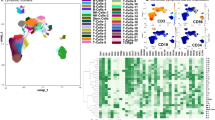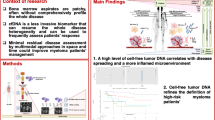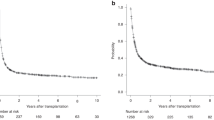Abstract
Donor T-cells transferred after allogeneic stem cell transplantation (alloSCT) can result in long-term disease control in myeloma by the graft-versus-myeloma (GvM) effect. However, T-cell therapy may show differential effectiveness against bone marrow (BM) infiltration and focal myeloma lesions resulting in different control and progression patterns. Outcomes of 43 myeloma patients who underwent T-cell-depleted alloSCT with scheduled donor lymphocyte infusion (DLI) were analyzed with respect to diffuse BM infiltration and focal progression. For comparison, 12 patients for whom a donor search was started but no alloSCT was performed, were analyzed. After DLI, complete disappearance of myeloma cells in BM occurred in 86% of evaluable patients. The probabilities of BM progression-free survival (PFS) at 2 years after start of donor search, alloSCT and DLI, were 17% (95% confidence interval 0–38%), 51% (36–66%), and 62% (44–80%) respectively. In contrast, the probabilities of focal PFS at 2 years after start of donor search, alloSCT and DLI, were 17% (0–38%), 30% (17–44%) and 28% (11–44%), respectively. Donor-derived T-cell responses effectively reduce BM infiltration, but not focal progression in myeloma, illustrating potent immunological responses in BM with only limited effect of T-cells on focal lesions.
This is a preview of subscription content, access via your institution
Access options
Subscribe to this journal
Receive 12 print issues and online access
$259.00 per year
only $21.58 per issue
Buy this article
- Purchase on SpringerLink
- Instant access to full article PDF
Prices may be subject to local taxes which are calculated during checkout




Similar content being viewed by others
References
Mateos MV, San Miguel JF . How should we treat newly diagnosed multiple myeloma patients? Hematology Am Soc Hematol Educ Program 2013; 2013: 488–495.
Moreau P . Death of frontline allo-SCT in myeloma. Blood 2012; 119: 6178–6179.
Ahmad I, LeBlanc R, Cohen S, Lachance S, Kiss T, Sauvageau G et al. Favorable long-term outcome of patients with multiple myeloma using a frontline tandem approach with autologous and non-myeloablative allogeneic transplantation. Bone Marrow Transplant 2016; 51: 529–535.
Lokhorst HM, van der Holt B, Cornelissen JJ, Kersten MJ, van Oers M, Raymakers R et al. Donor versus no-donor comparison of newly diagnosed myeloma patients included in the HOVON-50 multiple myeloma study. Blood 2012; 119: 6219–6225 quiz 399.
Dhakal B, Vesole DH, Hari PN . Allogeneic stem cell transplantation for multiple myeloma: is there a future? Bone Marrow Transplant 2016; 51: 492–500.
Krishnan A, Pasquini MC, Logan B, Stadtmauer EA, Vesole DH, Alyea E 3rd et al. Autologous haemopoietic stem-cell transplantation followed by allogeneic or autologous haemopoietic stem-cell transplantation in patients with multiple myeloma (BMT CTN 0102): a phase 3 biological assignment trial. Lancet Oncol 2011; 12: 1195–1203.
Gahrton G, Iacobelli S, Bjorkstrand B, Hegenbart U, Gruber A, Greinix H et al. Autologous/reduced-intensity allogeneic stem cell transplantation vs autologous transplantation in multiple myeloma: long-term results of the EBMT-NMAM2000 study. Blood 2013; 121: 5055–5063.
Moreau P, Garban F, Attal M, Michallet M, Marit G, Hulin C et al. Long-term follow-up results of IFM99-03 and IFM99-04 trials comparing nonmyeloablative allotransplantation with autologous transplantation in high-risk de novo multiple myeloma. Blood 2008; 112: 3914–3915.
Ali SA, Shi V, Maric I, Wang M, Stroncek DF, Rose JJ et al. T cells expressing an anti-B-cell maturation antigen chimeric antigen receptor cause remissions of multiple myeloma. Blood 2016; 128: 1688–1700.
van Bergen CA, Kester MG, Jedema I, Heemskerk MH, van Luxemburg-Heijs SA, Kloosterboer FM et al. Multiple myeloma-reactive T cells recognize an activation-induced minor histocompatibility antigen encoded by the ATP-dependent interferon-responsive (ADIR) gene. Blood 2007; 109: 4089–4096.
Bethge WA, Hegenbart U, Stuart MJ, Storer BE, Maris MB, Flowers ME et al. Adoptive immunotherapy with donor lymphocyte infusions after allogeneic hematopoietic cell transplantation following nonmyeloablative conditioning. Blood 2004; 103: 790–795.
Orsini E, Alyea EP, Chillemi A, Schlossman R, McLaughlin S, Canning C et al. Conversion to full donor chimerism following donor lymphocyte infusion is associated with disease response in patients with multiple myeloma. Biol Blood Marrow Transplant 2000; 6: 375–386.
Klein JP, Shu Y . Multi-state models for bone marrow transplantation studies. Stat Methods Med Res 2002; 11: 117–139.
Eefting M, Halkes CJ, de Wreede LC, van Pelt CM, Kersting S, Marijt EW et al. Myeloablative T cell-depleted alloSCT with early sequential prophylactic donor lymphocyte infusion is an efficient and safe post-remission treatment for adult ALL. Bone Marrow Transplant 2014; 49: 287–291.
Klein JP, Keiding N, Shu Y, Szydlo RM, Goldman JM . Summary curves for patients transplanted for chronic myeloid leukaemia salvaged by a donor lymphocyte infusion: the current leukaemia-free survival curve. Br J Haematol 2000; 109: 148–152.
Klein JP, Szydlo RM, Craddock C, Goldman JM . Estimation of current leukaemia-free survival following donor lymphocyte infusion therapy for patients with leukaemia who relapse after allografting: application of a multistate model. Stat Med 2000; 19: 3005–3016.
de Wreede LC, Fiocco M, Putter H . The mstate package for estimation and prediction in non- and semi-parametric multi-state and competing risks models. Comput Methods Programs Biomed 2010; 99: 261–274.
de Wreede LC, Fiocco M, Putter H . mstate: an R package for the analysis of competing risks and multi-state models. J Stat Softw 2011; 38: 1–30.
Brinkman CC, Rouhani SJ, Srinivasan N, Engelhard VH . Peripheral tissue homing receptors enable T cell entry into lymph nodes and affect the anatomical distribution of memory cells. J Immunol 2013; 191: 2412–2425.
Stevanovic S, van Bergen CA, van Luxemburg-Heijs SA, van der Zouwen B, Jordanova ES, Kruisselbrink AB et al. HLA class II upregulation during viral infection leads to HLA-DP-directed graft-versus-host disease after CD4+ donor lymphocyte infusion. Blood 2013; 122: 1963–1973.
van der Voort R, Volman TJ, Verweij V, Linssen PC, Maas F, Hebeda KM et al. Homing characteristics of donor T cells after experimental allogeneic bone marrow transplantation and posttransplantation therapy for multiple myeloma. Biol Blood Marrow Transplant 2013; 19: 378–386.
Luft T, Moos M, Goldschmidt H, Ho AD, Gorner M . Dissociation of putative graft-versus-haematopoiesis and graft-versus-myeloma effects in patients with rapidly progressive multiple myeloma. Br J Haematol 2003; 123: 646–653.
Minnema MC, van de Donk NW, Zweegman S, Hegenbart U, Schonland S, Raymakers R et al. Extramedullary relapses after allogeneic non-myeloablative stem cell transplantation in multiple myeloma patients do not negatively affect treatment outcome. Bone Marrow Transplant 2008; 41: 779–784.
Peggs KS, Mackinnon S, Williams CD, D'Sa S, Thuraisundaram D, Kyriakou C et al. Reduced-intensity transplantation with in vivo T-cell depletion and adjuvant dose-escalating donor lymphocyte infusions for chemotherapy-sensitive myeloma: limited efficacy of graft-versus-tumor activity. Biol Blood Marrow Transplant 2003; 9: 257–265.
Novitzky N, Thomas V, du Toit C . Prevention of graft vs. host disease with alemtuzumab 'in the bag' decreases early toxicity of stem cell transplantation and in multiple myeloma is associated with improved long-term outcome. Cytotherapy 2008; 10: 45–53.
Kroger N, Solano C, Wolschke C, Bandini G, Patriarca F, Pini M et al. Antilymphocyte globulin for prevention of chronic graft-versus-host disease. N Engl J Med 2016; 374: 43–53.
von dem Borne PA, Starrenburg CW, Halkes SJ, Marijt WA, Fibbe WE, Falkenburg JH et al. Reduced-intensity conditioning allogeneic stem cell transplantation with donor T-cell depletion using alemtuzumab added to the graft ('Campath in the bag'). Curr Opin Oncol 2009; 21: S27–S29.
D'Sa S, Peggs K, Pizzey A, Verfuerth S, Thuraisundaram D, Watts M et al. T- and B-cell immune reconstitution and clinical outcome in patients with multiple myeloma receiving T-cell-depleted, reduced-intensity allogeneic stem cell transplantation with an alemtuzumab-containing conditioning regimen followed by escalated donor lymphocyte infusions. Br J Haematol 2003; 123: 309–322.
Alyea E, Weller E, Schlossman R, Canning C, Webb I, Doss D et al. T-cell—depleted allogeneic bone marrow transplantation followed by donor lymphocyte infusion in patients with multiple myeloma: induction of graft-versus-myeloma effect. Blood 2001; 98: 934–939.
Kroger N, Kruger W, Renges H, Zabelina T, Stute N, Jung R et al. Donor lymphocyte infusion enhances remission status in patients with persistent disease after allografting for multiple myeloma. Br J Haematol 2001; 112: 421–423.
Levenga H, Schaap N, Maas F, Esendam B, Fredrix H, Greupink-Draaisma A et al. Partial T cell-depleted allogeneic stem cell transplantation following reduced-intensity conditioning creates a platform for immunotherapy with donor lymphocyte infusion and recipient dendritic cell vaccination in multiple myeloma. Biol Blood Marrow Transplant 2010; 16: 320–332.
Kroger N, Badbaran A, Lioznov M, Schwarz S, Zeschke S, Hildebrand Y et al. Post-transplant immunotherapy with donor-lymphocyte infusion and novel agents to upgrade partial into complete and molecular remission in allografted patients with multiple myeloma. Exp Hematol 2009; 37: 791–798.
Rajkumar SV . Updated diagnostic criteria and staging system for multiple myeloma. Am Soc Clin Oncol Educ Book 2016; 35: e418–e423.
Fairfield H, Falank C, Avery L, Reagan MR . Multiple myeloma in the marrow: pathogenesis and treatments. Ann N Y Acad Sci 2016; 1364: 32–51.
Kroger N, Shimoni A, Zagrivnaja M, Ayuk F, Lioznov M, Schieder H et al. Low-dose thalidomide and donor lymphocyte infusion as adoptive immunotherapy after allogeneic stem cell transplantation in patients with multiple myeloma. Blood 2004; 104: 3361–3363.
El-Cheikh J, Crocchiolo R, Furst S, Ladaique P, Castagna L, Faucher C et al. Lenalidomide plus donor-lymphocytes infusion after allogeneic stem-cell transplantation with reduced-intensity conditioning in patients with high-risk multiple myeloma. Exp Hematol 2012; 40: 521–527.
Hoevenaren IA, van Vulpen LF, Levenga H, Minnema MC, Raymakers R . Bortezomib and donor lymphocyte infusion in multiple myeloma relapsed after allo-SCT does not result in durable remissions. Bone Marrow Transplant 2011; 46: 319–321.
Rondelli D, Bandini G, Cavo M, Re F, Motta M, Senese B et al. Discrepancy between serological complete remission and concomitant new bone lytic lesions after infusion of escalating low doses of donor lymphocytes in multiple myeloma: a case report. Bone Marrow Transplant 1999; 24: 685–687.
Falkenburg JH, Jedema I . Allo-reactive T cells for the treatment of hematological malignancies. Mol Oncol 2015; 9: 1894–1903.
Di Rosa F, Pabst R . The bone marrow: a nest for migratory memory T cells. Trends Immunol 2005; 26: 360–366.
Rasche L, Rollig C, Stuhler G, Danhof S, Mielke S, Grigoleit GU et al. Allogeneic hematopoietic cell transplantation in multiple myeloma: focus on longitudinal assessment of donor chimerism, extramedullary disease, and high-risk cytogenetic features. Biol Blood Marrow Transplant 2016; 22: 1988–1996.
van de Donk NW, Kroger N, Hegenbart U, Corradini P, San Miguel JF, Goldschmidt H et al. Prognostic factors for donor lymphocyte infusions following non-myeloablative allogeneic stem cell transplantation in multiple myeloma. Bone Marrow Transplant 2006; 37: 1135–1141.
Peggs K, Mackinnon S . Graft-versus-myeloma: are durable responses a clinical reality following donor lymphocyte infusion? Leukemia 2004; 18: 1541–1542.
Ghobrial IM . Myeloma as a model for the process of metastasis: implications for therapy. Blood 2012; 120: 20–30.
Posthuma EF, Marijt EW, Barge RM, van Soest RA, Baas IO, Starrenburg CW et al. Alpha-interferon with very-low-dose donor lymphocyte infusion for hematologic or cytogenetic relapse of chronic myeloid leukemia induces rapid and durable complete remissions and is associated with acceptable graft-versus-host disease. Biol Blood Marrow Transplant 2004; 10: 204–212.
van der Zouwen B, Kruisselbrink AB, Jordanova ES, Rutten CE, von dem Borne PA, Falkenburg JH et al. Alloreactive effector T cells require the local formation of a proinflammatory environment to allow crosstalk and high avidity interaction with nonhematopoietic tissues to induce GVHD reactivity. Biol Blood Marrow Transplant 2012; 18: 1353–1367.
Ishiyama K, Takami A, Suzuki S, Konaka H, Namiki M, Ooi A et al. Relationship between tumor-infiltrating T lymphocytes and clinical response after reduced-intensity allogeneic hematopoietic stem cell transplantation for advanced renal cell carcinoma: a single center prospective study. Jpn J Clin Oncol 2009; 39: 807–812.
Kearl TJ, Jing W, Gershan JA, Johnson BD . Programmed death receptor-1/programmed death receptor ligand-1 blockade after transient lymphodepletion to treat myeloma. J Immunol 2013; 190: 5620–5628.
Armand P . Immune checkpoint blockade in hematologic malignancies. Blood 2015; 125: 3393–3400.
Davids MS, Kim HT, Bachireddy P, Costello C, Liguori R, Savell A et al. Ipilimumab for patients with relapse after allogeneic transplantation. N Engl J Med 2016; 375: 143–153.
Acknowledgements
This work was supported by research grant 2008-4263 from the Dutch Cancer Society, Amsterdam, The Netherlands. We thank Illyea Hawke (DKMS, Germany) for correcting the language of the manuscript.
Author information
Authors and Affiliations
Corresponding author
Ethics declarations
Competing interests
The authors declare no conflict of interest.
Additional information
Supplementary Information accompanies this paper on Bone Marrow Transplantation website
Supplementary information
Rights and permissions
About this article
Cite this article
Eefting, M., de Wreede, L., Von dem Borne, P. et al. Donor T-cell responses and disease progression patterns of multiple myeloma. Bone Marrow Transplant 52, 1609–1615 (2017). https://doi.org/10.1038/bmt.2017.201
Received:
Revised:
Accepted:
Published:
Issue date:
DOI: https://doi.org/10.1038/bmt.2017.201
This article is cited by
-
Long-term survival without graft-versus-host-disease following infusion of allogeneic myeloma-specific Vβ T cell families
Journal for ImmunoTherapy of Cancer (2019)



